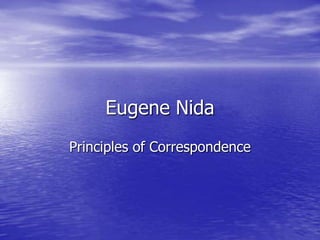
Eugene nida Principles of Correspondence
- 1. Eugene Nida Principles of Correspondence
- 2. • Nida there are not two same languages as there is no correspondence between languages, so the result is that there can not be fully exact translations.
- 3. Different types of translations • Free or paraphrastic, close or literal translations. There are also ultraliteral translations as interlinears; but others may involve highly concordant relationships, e.g. the same SL word is always translated by only one word in receptor-language word.
- 4. • Three different basic factors in translating • 1. the nature of the message, • 2. the purpose of the author and, by proxy, of translator, and • 3. the type of audience
- 5. The nature of the message • Content and form takes the higher consideration in the message. In most cases content and form goes hand in hand with each other, but sometimes content takes the primary consideration or visa versa form takes the primary considerations. And very rarely they can be produced in a translation, so form in most cases is sacrificed for the sake of content.
- 6. The purpose of the author and, by proxy, of translator • Translator’s purpose is similar to that of the original author. Another one may be information about the content and form, or this may not be enough he might want to make his translation meaningful into TL for example by translation idioms with their exact meaning in TL not translating them word by word.
- 7. The type of audience • The decoding ability of the audience should be important. Nida points four principal levels in decoding abliity in any language: 1. the capacity of children, 2. the double-standard capacity of new literates, 3 the capacity of the average literate adult, 4. the usually high capacity of specialists (doctors, theologians, philosophers, scienti sts, etc.).
- 8. Two basic orientations in translating • Formal equivalence • Dynamic equivalence
- 9. Formal equivalence • The attention is on the message, both in form and content. In this translation the translator is concerned with such correspondence as poetry to poetry, sentence to sentence, and concept to concept. The message of the receptor language should be compared to the source language message as in this way it can determine standards of accuracy and correctness.
- 10. • In this type of translation the translator tries to reproduces as literally and meaningfully as possible the form and content of the original.
- 11. Dynamic equivalence • It is focused more on “the principle of equivalent effect” • The translator is not focused on the matching the message of the receptor language to that of the source language. But he is more concerned with the dynamic relationship between receptor and message as it was to the original receptors and the message. The translator tries to uses a complete natural expressions of his own language making the message of the text comprehensible to the reader even though he might not understand the patterns of the source-language.
- 12. Linguistic and Cultural distance • Languages and cultures can be closely related for example Hebrew and Arabic. And when translating from one to another a translator might not expect to have lots of problems, but he most pay attention to false friends, even if languages are related they may have only superficial similarities. • Languages aren’t the same even though they belong to the same language family but their culture is very different, e.g. German and Hungarian.
- 13. Definitions of translating • There are a lot of translation definitions because a vast number of people undertook to discuss the same subject. Also the differences in the material translated and the audience are different.
- 14. Principles governing a translation oriented toward formal equivalence • F-E is basically source oriented in both the form and content. • And it attempts to reproduce formal elements: 1 grammatical units, 2 consistency in word usage, 3 meaning in terms of source context.
- 15. Grammatical Unites • A) translating nouns by nouns, verbs by verbs, etc,; b) keeping all phrases and sentences intact, c) preserving all formal indicators, e.g. marks of punctuation, paragraph breaks, and poetic indentation.
- 16. Consistency in word usage • F-E translation usually aims at so-called concordance of terminology; that is, a source term in render by the corresponding term in receptor document.
- 17. Meaning in terms of source context • To produce meaning F-E doesn’t change anything not even in translating idioms when we translate them literally.
- 18. Principles governing translations oriented toward dynamic equivalence • D-E is not concerned with source message, but with the receptor response. In D-E translations we attempt to make our translation sound as if it were written in our own language. But the our translation most reflect the meaning and the intent of the source text.
- 19. • Nida defined D-E as the closest natural equivalent to the source-language message. This definition contains three terms: 1. equivalence, which points toward the source-language message, 2. natural, which points toward the receptor language, and 3. closest, which binds the two orientations together on the basis of the highest degree of approximation.
